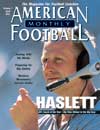AMERICAN FOOTBALL MONTHLY THE #1 RESOURCE FOR FOOTBALL COACHES
Article CategoriesAFM Magazine
|
Moving TargetA quarterback who knows how to throw on the run will never be caught flat-footedby: Jim Collins Head coach, Capital University © More from this issue Over the last several years, no team in Ohio Athletic Conference has attempted more passes and completed more of them than Capital University. Needless to say, we are a passing team and philosophically go into every ball game thinking pass first and run second. Our pass offense is multi-dimensional. We use multiple formations, but for the most part use one back and four wide receivers. We throw from a variety of launching points, use a multitude of actions, and run patterns designed for multiple coverages and blitzes. Our practices are organized to allow our quarterbacks and receivers to work on passing and catching about 90 percent of the time. A big part of what we like to do is our sprint out passing game. We feel that moving the pocket to the outside brings the quarterback closer to the receiver and puts immediate pressure....The full article can only be seen by subscribers.
|
|
|||||||
| HOME |
MAGAZINE |
SUBSCRIBE | ONLINE COLUMNISTS | COACHING VIDEOS |
Copyright 2025, AmericanFootballMonthly.com
All Rights Reserved





